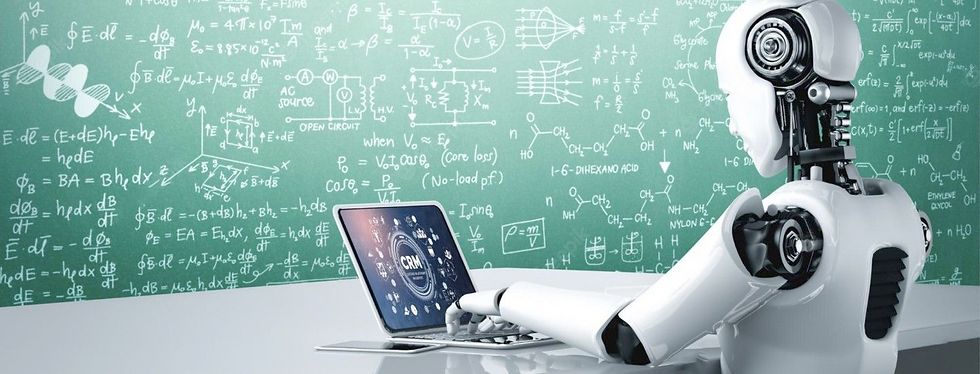The Role of Interactive Learning AI Assistants in Modern Education Systems and Their Future Prospects
- Aisha Washington

- Jul 30
- 7 min read

Interactive learning AI assistants are intelligent software systems designed to facilitate personalized, engaging, and adaptive learning experiences through natural interaction between learners and technology. These AI assistants can respond to student queries, tailor educational content dynamically, and support both learners and educators in real time.
In today's rapidly evolving modern education systems, the integration of AI in education has become a pivotal focus. Schools and universities worldwide are adopting these technologies to enhance learning outcomes, improve accessibility, and empower teachers. Interactive learning AI assistants are no longer futuristic concepts—they are active agents reshaping how education is delivered and experienced.
This article provides an in-depth exploration of interactive learning AI assistants, tracing their evolution, practical applications, benefits, challenges, and future potential. Readers will gain insight into how these technologies are transforming classrooms today and what lies ahead for educators, students, and EdTech innovators.
For a broader understanding of AI’s role across educational contexts, see our detailed guide on as well as UNESCO’s comprehensive report on AI in Education that highlights global trends and policy recommendations.
1. Background: Evolution of AI in Modern Education Systems

1.1 The Rise of Digital Learning Platforms
The journey toward interactive learning AI assistants began with the widespread adoption of digital learning platforms. Early eLearning tools focused primarily on content delivery, enabling students to access materials online at their own pace. However, these platforms were largely passive—students consumed static content without personalized feedback or interaction.
Over the past decade, advances in machine learning and natural language processing have ushered in a new era of AI-driven environments capable of real-time assessment, adaptation, and engagement. According to EDUCAUSE data, over 65% of higher education institutions had integrated some form of AI technology by 2022, signaling a significant shift from traditional eLearning to intelligent platforms that respond dynamically to learner need.
This evolution marks a pivotal moment: digital learning platforms are no longer just repositories for information but interactive partners in education.
1.2 Key Concepts and Definitions
An AI teaching assistant or virtual learning assistant is a subtype of AI designed specifically to support teaching and learning activities. These assistants range from chatbots that answer student questions to sophisticated systems that analyze performance data and suggest personalized next steps.
There are two broad categories:
Interactive AI assistants: Engage in two-way communication with learners or educators, providing tailored support, answering queries, and adapting content.
Non-interactive AI tools: Perform background functions such as data analytics or automated grading without direct dialogue.
Understanding this distinction clarifies how interactive assistants enhance engagement rather than merely automating tasks.
1.3 Milestones in AI Integration
A landmark example is the “Jill Watson” AI teaching assistant deployed at Georgia Tech. Jill Watson used IBM’s Watson platform to answer routine student questions in online courses with remarkable accuracy, reducing instructor workload while maintaining high-quality interaction.
Such case studies highlight how early integration of AI assistants proved effective in live educational settings, paving the way for more advanced implementations globally.
2. Current Applications of Interactive Learning AI Assistants

2.1 Personalized Learning Paths
One of the most transformative contributions of interactive learning AI assistants is their ability to deliver personalized learning experiences. Through algorithms that analyze student performance, preferences, and engagement patterns, these assistants tailor content complexity, pacing, and delivery methods accordingly.
An exemplary model is the “GPS of Education” system used in select K-12 districts in the U.S., which maps individual student progress against curriculum standards and recommends customized learning activities.
This adaptive learning AI approach not only improves comprehension but also fosters learner autonomy by meeting students where they are.
2.2 Classroom Support and Teacher Empowerment
Beyond aiding students directly, AI assistants serve as powerful tools for teacher empowerment. Automating administrative tasks such as grading multiple-choice assignments or tracking attendance frees educators to focus on instructional quality and student interaction.
Code.org’s AI Teaching Assistant exemplifies this role by providing coding students with instant feedback on exercises while alerting teachers to common misconceptions or difficulties.
For more innovative solutions supporting educators, explore our resource on .
2.3 Real-Time Student Engagement and Support
Interactive AI assistants facilitate real-time engagement through conversational Q&A interfaces, immediate feedback loops, and gamification elements that motivate learners. This instant support enhances student retention by reducing frustration and encouraging continuous participation.
Studies demonstrate that students receiving timely AI-driven feedback demonstrate higher completion rates, particularly in online and hybrid learning models.
2.4 Accessibility and Inclusivity
AI-powered tools play a critical role in promoting inclusive education by adapting learning content to diverse needs—including language translation, speech recognition for students with disabilities, and tailored pacing for learners requiring additional support.
By breaking down traditional barriers, accessibility AI fosters equitable opportunities across socio-economic backgrounds and learning abilities.
3. Benefits of AI Assistants in Education
3.1 Improved Learning Outcomes
Empirical evidence supports the positive impact of interactive learning AI assistants on academic achievement. Institutions report measurable improvements in student performance metrics such as test scores, course completion rates, and engagement levels after integrating AI systems.
These tools enable more precise identification of gaps in understanding and provide targeted interventions—key drivers behind improved outcomes.
3.2 Teacher Efficiency and Satisfaction
Teachers benefit significantly from reduced administrative burdens. AI assistants automate routine grading and data collection tasks, allowing educators to dedicate more time to curriculum development and one-on-one mentoring.
This shift contributes to higher job satisfaction, as teachers experience less burnout and greater professional fulfillment .
3.3 Scalability and Resource Optimization
AI assistants provide scalable solutions for institutions facing resource constraints or large class sizes. By delivering consistent quality and individualized attention at scale, they optimize educational resources without compromising student experience.
3.4 Fostering 21st-Century Skills
Beyond content mastery, interactive AI encourages development of critical thinking, problem-solving, digital literacy, and self-directed learning—skills essential for success in the modern workforce.
4. Case Studies: Real-World Implementations

4.1 K-12 Education: Personalized Pathways and Engagement
Several U.S. school districts have successfully integrated AI systems that customize curricula based on student data analytics. These initiatives report increased engagement among diverse student populations and improved standardized test scores.
4.2 Higher Education: AI in University Classrooms
At the University of Michigan, the Maizey chatbot supports students enrolled in distributed systems courses by answering complex technical questions instantly, improving comprehension outside traditional lecture hours.
Similarly, George Washington University employs AI teaching assistants in humanities courses to encourage deeper student interaction with texts through conversational prompts.
4.3 EdTech Industry Innovations
Industry leaders like Code.org and Georgia Tech continue to push the boundaries of interactive learning AI assistants by developing platforms that integrate real-time diagnostics with pedagogical strategies—enabling seamless teacher-AI collaboration.
For an overview of cutting-edge tools shaping post-secondary education, see .
5. Challenges and Ethical Considerations

5.1 Data Privacy and Security
The collection and processing of sensitive student data raise significant concerns about AI in education data privacy compliance with laws such as FERPA (U.S.) and GDPR (EU). Ensuring robust encryption protocols and transparent data governance policies is paramount.
5.2 Equity and Access
While AI promises inclusivity, unequal access to reliable internet or devices risks widening educational disparities—particularly affecting under-resourced communities.
5.3 Teacher Roles and Job Security
There is understandable apprehension around AI replacing educators; however, current consensus views AI as a complementary empowerment tool rather than a substitute for human instruction .
5.4 Technical and Implementation Barriers
Integrating AI assistants demands substantial investment in infrastructure and professional development for teachers to effectively leverage these tools. Without adequate training, adoption may falter.
5.5 Solutions and Best Practices
To address these issues responsibly:
Adopt transparent data policies
Prioritize equity-focused deployment
Provide continuous educator training
Foster collaboration between human instructors and AI systems
Refer to our guide on for detailed frameworks.
6. Industry Trends and Future Prospects

6.1 Emerging Trends in AI for Education
Conversational AI is evolving into multimodal assistants combining voice recognition, visual aids, and contextual data to create richer interactions. Intelligent tutoring systems are incorporating emotional intelligence to better respond to learner motivation and mood.
6.2 The Future Classroom: Predictions and Scenarios
The AI classroom of the future envisions seamless collaboration between human educators and AI—where personalized instruction is augmented by predictive analytics guiding proactive interventions (future of AI in education).
Policy shifts will likely emphasize ethical standards alongside innovative funding models supporting widespread access.
6.3 Opportunities for Stakeholders
Educators can benefit from upskilling programs focused on AI literacy; students gain agency through personalized pathways; EdTech developers have expansive roles designing intuitive interfaces grounded in pedagogy.
7. FAQ: Interactive Learning AI Assistants in Education

Q: What are interactive learning AI assistants? A: They are intelligent software tools that engage learners through real-time interaction—answering questions, personalizing content, and supporting educators throughout the learning process.
Q: How do AI assistants personalize education? A: By analyzing individual performance data and preferences to tailor lessons’ difficulty level, pace, and format uniquely for each student.
Q: Do AI assistants replace teachers? A: No; they serve as collaborators that reduce administrative workload while enhancing teacher-student interaction quality.
Q: Are AI assistants safe and secure for students? A: When properly implemented with strong data privacy measures following regulations like FERPA or GDPR, they can be secure platforms for learning support.
Q: What are the main challenges of using AI in education? A: Challenges include data privacy concerns, equitable access disparities, teacher training needs, and infrastructure costs.
Q: How can schools get started with AI assistants? A: Begin by identifying specific needs such as grading automation or personalized tutoring; invest in teacher training; pilot programs with select classes before scaling broadly.
Q: What does the future hold for AI in education? A: Continued integration will deepen personalization, foster richer human-AI collaboration, improve accessibility globally, and reshape pedagogical models fundamentally.
8. Actionable Insights and Conclusion: Maximizing the Impact of AI Assistants in Education

The rise of interactive learning AI assistants represents a watershed moment for modern education systems, combining technology with pedagogy to unlock new potentials for personalized learning and teacher empowerment. While challenges around privacy, equity, and implementation remain significant, strategic adoption guided by ethical principles promises transformative benefits:
Enhanced student outcomes through adaptive learning
Increased teacher efficiency freeing time for meaningful engagement
Scalable solutions addressing diverse learner needs
Development of critical skills necessary for future careers
Educators should pursue incremental integration starting with clear objectives aligned with curriculum goals while investing in professional development focused on digital literacy. Policymakers must prioritize equitable infrastructure access alongside robust data governance frameworks.
Over the coming decade, the future of AI in education will be shaped by collaboration among educators, technologists, policymakers, and learners themselves—pioneering a new era where intelligent assistance augments human potential rather than replaces it.


